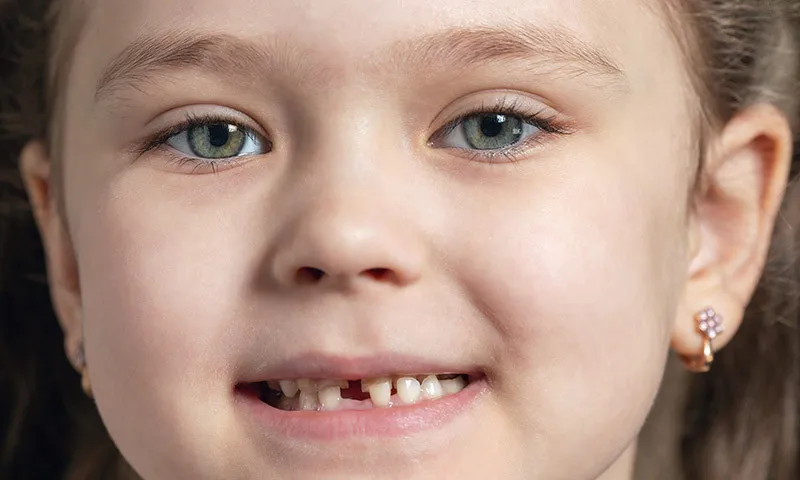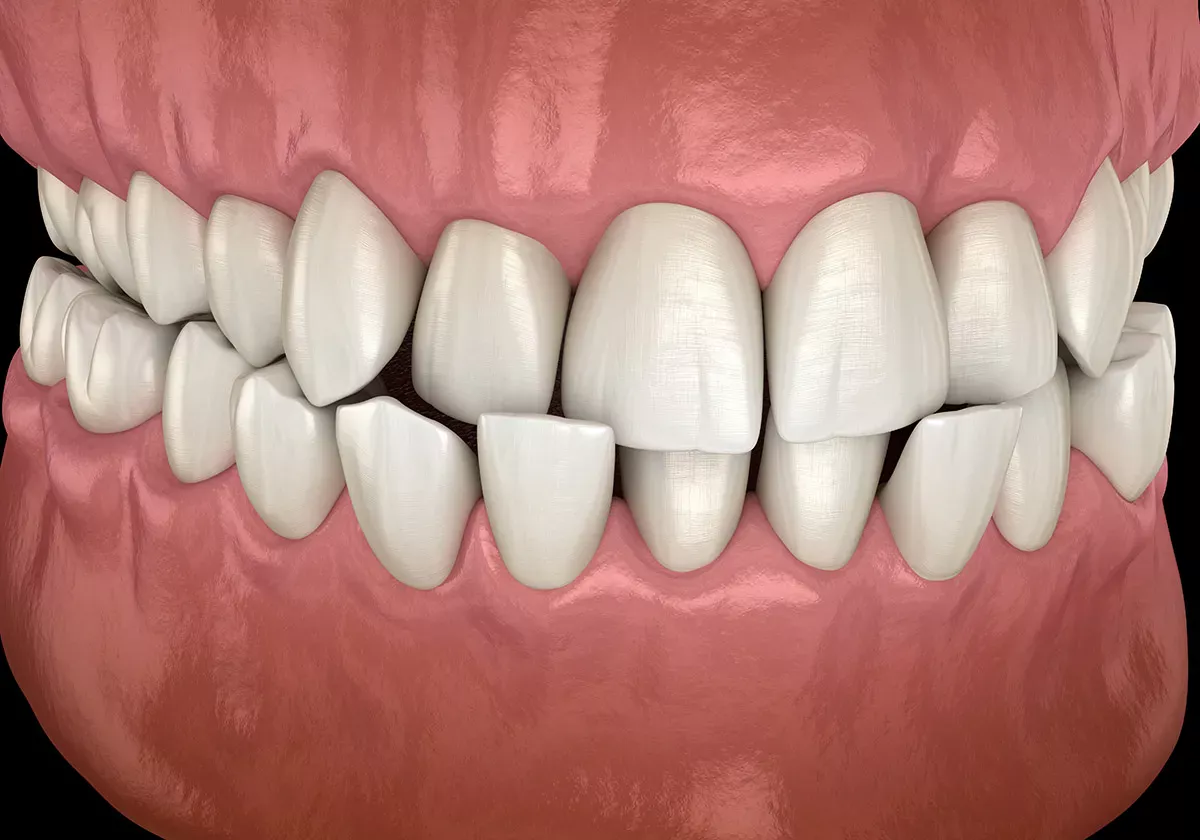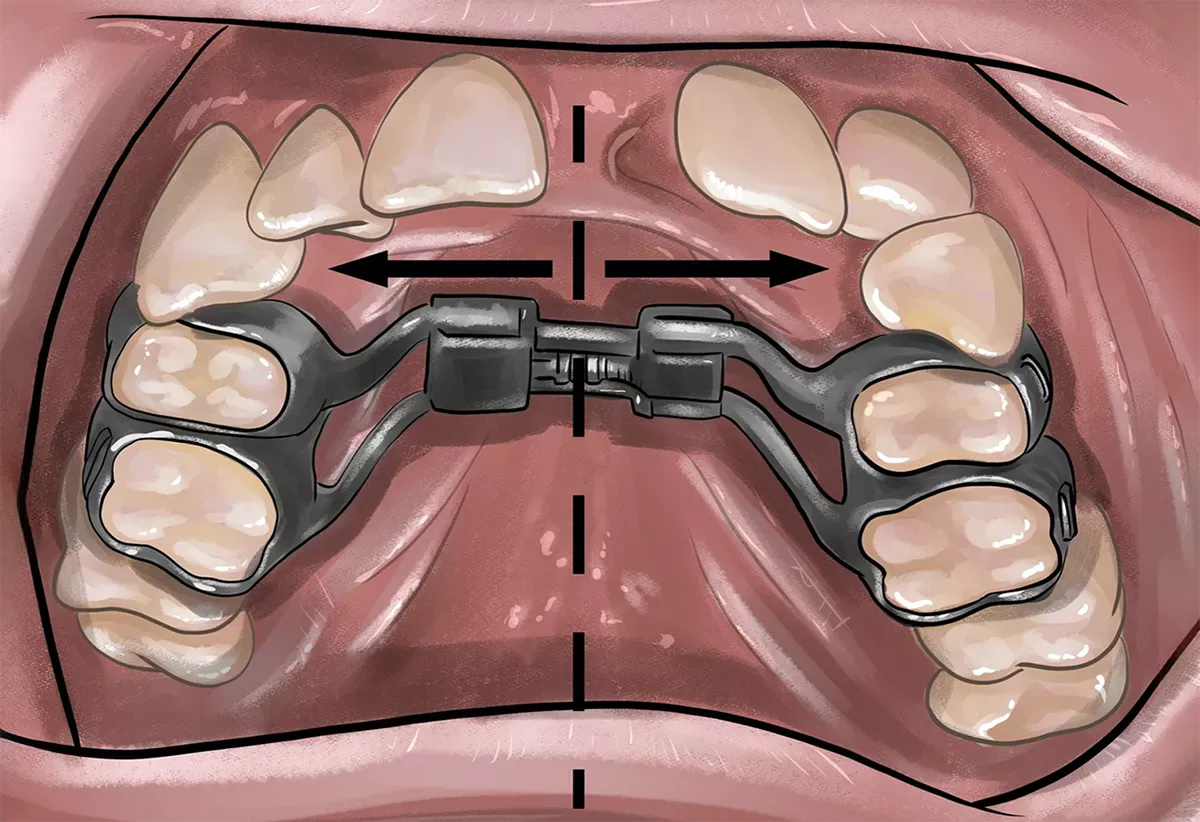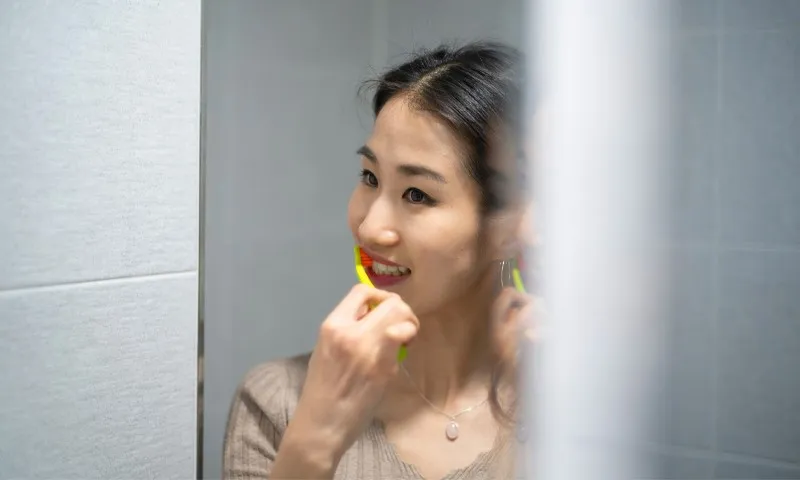Definition: Crossbite - what is it?
The so-called crossbite is one of many malocclusions in which the teeth do not correspond to the ideal dentition. Ideal dentition? Yes, it really does exist. In this perfect world, the teeth are arranged symmetrically without much space between them. The upper jaw is slightly wider than the lower jaw and the upper front teeth bite about two to three millimetres above the lower teeth.
With a crossbite, it is the other way round, which is why the malocclusion is also called reversed bite or crooked bite. In this malocclusion, the proportions of the upper and lower jaws are not correct. As a result, the side or front teeth of the lower jaw bite in front of the teeth of the upper jaw. They are therefore too far inwards, while the teeth in the lower jaw are too far outwards. A topsy-turvy world. This phenomenon can occur on one or both sides or only affect individual teeth. The result of the misalignment is that the teeth cannot close correctly - they bite past each other sideways.
Crossbite is the most common jaw malocclusion. It is rarely present before birth or inherited. As a rule, crossbite is caused by certain habits in childhood - such as sucking on the wrong dummy or sucking on the finger.
What does a crossbite look like?
The diagnosis crossbite can only be made by an orthodontist or dentist. Nevertheless, there are some characteristic signs that give you an initial indication that a person suffers from this malocclusion. Depending on whether only individual teeth or an entire row of teeth are affected, an unnatural position of the teeth can be seen in the person's dentition. As described above, the upper teeth are not positioned above the lower teeth, but the other way round.
Different types of crossbite
There are three types of crossbite, which we would like to explain to you below.
Head bite
In a so-called overbite, the teeth of the upper jaw meet the teeth of the lower jaw directly when biting together. Normally, the incisors are positioned above the lower incisors when biting together. As a result, our incisors and molars interlock like cogwheels and are not positioned exactly on top of each other, as is the case with a head bite.
Unilateral crossbite
One-sided crossbite (also known as unilateral crossbite) is characterised by the fact that the malocclusion only occurs on one side of the dentition. This means that the teeth of the upper and lower jaw bite together correctly on one side - but not on the other. There, the teeth in the lower jaw are too far outwards and the teeth in the upper jaw are too far inwards.
Bilateral crossbite
As the name suggests, the malocclusion in bilateral crossbite (also: lateral crossbite) occurs on both sides of the upper and lower jaw. This means that the teeth of the lower jaw are positioned too far outwards so that the teeth of the upper jaw bite behind those of the lower jaw when they meet.
In addition to this classification, a crossbite is also categorised according to where in the mouth the malocclusion occurs:
Anterior crossbite
With an anterior crossbite (also: anterior crossbite or frontal crossbite), the incisors are affected. This type of malocclusion is often referred to as a forward bite and is usually the most obvious visually.
Posterior crossbite
A posterior crossbite is when the teeth in the rear area are affected - especially the small and large molars. This malocclusion is not as visible as an anterior crossbite.
Causes: How does a crossbite develop?
In most people affected, a crossbite usually develops in infancy and early childhood. This means that the milk teeth are already affected. This is often caused by a different rate of growth in the jaw and mouth area. This in turn can be due to a muscular imbalance.
However, there are also other reasons that can lead to a crossbite. We have summarised possible causes for you here:
- Thumb sucking
- Sucking on bottles and soothers that are not specially designed for children's jaws, however easily mouldable they may be
- Heavy dummy chains can press the dummy unfavourably against the palate
- Irregular growth in the jaw and mouth area
- Dental diseases in the early developmental phase
- Malformations of the jaw or skull shape
- Accidents that have affected the jaw
Good to know:
If babies have a teat, it's not bad per se. It just has to be the right one. The baby soothers from Curaprox are designed to support the development of the palate, jaw and teeth - without the risk of jaw deformities and malocclusions such as crossbite.
Symptoms and consequences of a crossbite
The most obvious symptom of a crossbite is the appearance of the teeth, as individual teeth or entire rows of teeth in the upper jaw bite behind the teeth in the lower jaw in this malocclusion. This can also result in asymmetries (a "crooked face") - for example, if the lower jaw grows to one side of the crossbite, which is unfortunately a risk of this malocclusion.
But changes are not only visual. A crossbite can have serious consequences for the person affected if they do not have it treated. We have summarised them for you here:
- Growth inhibition of the upper jaw
- Impaired speech development and development of speech disorders (e.g. lisp)
- Premature wear of the teeth due to incorrect loading
- Pain in the temporomandibular joints, also due to incorrect loading
- Restricted or impaired chewing function
- Postural disorders
- Headache
- Jaw and neck pain
- Problems with biting off
- Psychological problems due to altered optics
- Sleep disorders/sleep apnoea syndrome
- Developmental disorders in children
- Teeth grinding
- Slipped discs as a late consequence of asymmetries in posture
- Impaired nasal breathing
Crossbite: Who is affected?
In principle, both adults and children can suffer from a crossbite. To prevent subsequent damage in adulthood, it is therefore important to initiate treatment as early as possible - many orthodontists recommend treatment from the age of four to eight. As crossbite is usually already apparent in the primary dentition, it is therefore advisable for parents to have the malocclusion checked by a dentist or orthodontist at an early stage. This is because, without treatment, crossbite can worsen during the growth period and with increasing age.
In the following, we explain what such a treatment can look like.
Treating crossbite: Therapies at a glance
The aim of crossbite therapy is always to enlarge the upper jaw so that the upper and lower teeth can interlock correctly. There are several options available for this, which we would like to present to you here.
It is important to know that the orthodontist will always suggest an individualised treatment - also depending on whether, for example, there is only a slight crossbite or whether the malocclusion is very pronounced. The duration of treatment also depends on these factors. Unfortunately, it is therefore not possible to make a generalised prediction.
Loose braces
One option for correcting a crossbite is removable braces. They exert pressure on the teeth and gradually widen the palate. The disadvantage of this method is that the position of the teeth cannot be changed. Treatment with loose braces is therefore generally more suitable for a slight crossbite. Wearing loose braces is also often a challenge for smaller children. It requires a lot of discipline to wear the braces continuously. However, this is precisely what is crucial for the success of treatment with loose braces. In addition, many smaller children often lose their braces.
Fixed braces (brackets)
A crossbite can also be corrected with fixed braces. To do this, the orthodontist attaches so-called brackets to the teeth with a special adhesive, which are then connected with a wire. This creates a pull in the desired position. In addition, the braces can be extended with elastics. To do this, the brackets are fitted with hooks to which the braces elastics are attached. They then exert additional pressure on the teeth and jaw and thus support the realignment of the teeth.
Invisible braces (aligners)
Under certain circumstances, it may be sufficient to wear invisible braces, for example in the case of a slightly pronounced form of crossbite. However, these so-called aligners (e.g. the Invisalign system) are particularly suitable as treatment for adults or adolescents for whom it is important that their braces are as unobtrusive as possible. Ask your dentist for advice on whether this method is suitable for you and find out about the costs of treatment in advance.
Read more: What should you bear in mind when having aligner therapy?
Expansion plate / Active plate
The expansion plate is a removable brace for the upper jaw. It can be used from the age of four and even in adulthood. As the name suggests, the expansion plate can be used to expand the upper jaw and thus eliminate the crossbite. The principle works in the same way as with "normal" braces: the plate is gradually expanded at medically prescribed intervals using a screw. After treatment with the expansion plate, children may require speech therapy treatment.
Palatal expansion
Palatal expansion is an option if you have a pronounced crossbite. The upper jaw is widened by the orthodontist or oral surgeon attaching fixed braces to the upper jaw. The palate can be widened once or twice a day by turning a screw.
The difference to "normal" braces is that the palatal expansion has a skeletal effect. This means that new bone is formed. The change is therefore permanent. Conventional braces, on the other hand, only cause the posterior teeth to tilt outwards. However, the change caused by normal braces can be unstable - renewed tooth displacement cannot be ruled out. Palatal expansion can also be used in primary dentition and is generally well accepted by children.
Crossbite surgery
In the case of severe crossbites, it may be necessary to perform an operation under general anaesthetic. The surgical procedure involves the oral surgeon first breaking the jaw to bring it into the desired position - i.e. so that the upper and lower teeth meet ideally. This new position is fixed with plates and screws. Depending on the individual starting position, the bone incision may be made in the upper or lower jaw inside the mouth. Sometimes it may be necessary to widen the palate in addition to the operation.
Good to know:
The appearance of a crossbite can be psychologically stressful. You can find many before and after pictures on the internet that show you which treatments can achieve which results. Don't let this impress or influence you too much. It is important to talk to your doctor in person, who will be able to tell you exactly what results and successes can be achieved in your case.
When to treat crossbite in children?
As you have already read, early treatment is very important and is also possible in the primary dentition. Specialists often recommend early treatment from the age of four. However, this is only a generalised statement. Your doctor will provide you with detailed information and advice and will also take other factors such as the severity of the crossbite into account.
Alternative treatment for crossbite: Is it possible?
The answer is: No. A crossbite can neither be treated with homeopathy nor with osteopathy. Globules and the like have no effect on an incorrect tooth position or problems with the jaw. You should therefore never resort to such alternative therapies, but consult an orthodontist at a very early stage. Especially with children, it is important not to lose any time in order to prevent later complaints.
Crossbite: What are the costs of treatment?
It is difficult to generalise about the costs of treating a crossbite. It always depends on the severity of the malocclusion. As a rough guide: fixed braces generally cost up to 7,000 euros. Removable braces cost around 1,000 to 1,500 euros per year. The good news is that crossbite therapy for adolescents up to the age of 18, but also for adults in Germany, is generally covered by health insurance. Adults usually pay in advance and can then apply for reimbursement.
If you have very special ideas and specifically want invisible braces, for example, you must be prepared to bear these extra costs yourself. Make sure you get a cost estimate and clarify the situation with your health insurance provider in advance. If your health insurance company does not cover the costs, which is very likely, you can at least claim your braces against tax and thus reduce your tax burden.
Preventing crossbite: with these tips
As bad habits are often behind the development of a crossbite, the best prevention is to avoid them. This includes preventing your child from sucking their thumb as much as possible and only offering them soothers that promote correct jaw growth. It is just as important to make regular visits to the dentist and preventive appointments with very young children from the very first tooth. This allows the dentist to recognise malocclusions and other abnormalities in the mouth at a very early stage and refer you and your child to an orthodontist if necessary.
To prevent children from developing fears of the dentist, you should also ensure very thorough dental hygiene. Make sure that your child enjoys brushing their teeth - good dental hygiene also reduces the risk of them experiencing unpleasant treatment at the dentist and associating a visit to the practice with a negative experience.
Good to know:
Brushing teeth from the very first tooth - with the baby toothbrush from Curaprox, you can clean little teeth gently and effectively. This is thanks to the fine filaments that gently treat the sensitive baby mouth and get into every crevice. Would you like to learn how to brush your baby's or toddler's teeth properly? Then take a look at our instructions here:
Sources
Orthodontic practice Dr med. dent. Peter Borg: Overbite.
Orthodontics Erkelenz: Braces elastics: Small helpers with a big effect.
Madsen Kieferorthopädie Mannheim, MVZ GmbH: The palatal expansion.
Mooci: Crossbite.
Practice of Dr med. dent. Andreas Köneke: The crossbite - causes and diagnoses.
Practice Dr Eva Krampf-Farsky: Expansion plate / Bertoni plate.
Schmieder, Eileen et al: Crossbite, at: flexikon.doccheck.com.
SMILIKE: Crossbite: Types, consequences and treatments for correction.
by Kunhardt, Lukas : Crossbite, on netdoktor.de.
Voslamber - Practice for orthodontics: Common malocclusions in children: The crossbite.
All websites last accessed on 6.12.2023
 Swiss premium oral care
Swiss premium oral care







